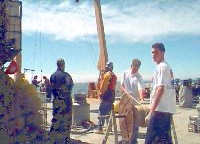| |
Student's
Report:
Hello, we are
Darin Tonks and Vito Maselli. We are Reefdogs that have gone to sea on
the Ronald Brown to study hydrothermal vents with Dr. Baker and the NOAA
Pacific Marine Environmental Laboratory (PMEL).
Each day is exciting, but
as our reefdog shipmates have described before, some days we work with
different departments. We have been working with the deck crew and we
thought that you would like to know a little about how they operate. The
first few days of our cruise, we were very busy on the deck. We helped
with hoisting the TEP moorings that popped up and casting the CTD (please
see Student Log entry #2 & 3 for acronym descriptions). That was when
we were over the Axial Volcano. Since then, we have cruised South to the
Cleft Segment of the Juan de Fuca Ridge and have been doing tow-yos for
two days.
While the tow-yos are in
operation, we busy our selves around the ship with Ordinary Seaman, Herb
Watson. Herb is a good teacher and is our immediate boss when we work
with the deck crew. He literally "taught us the ropes" and gave us a new
appreciation for hard work. Herb has been with the Brown for most of her
cruises and never looses his enthusiasm. He is quick with a joke and makes
hard work fun. Deck operations that require the coordination of departments
need constant radio and telephone communication.Acting
Chief Bosun Mate, David Owen gives instructions to the assisting seaman.
He calls the shots from the deck and tells the scientists what is happening.
The bridge monitors the whole operation and makes all of the final decisions.
We learned that there are
two ways to become an ordinary seaman. One is to get a letter of commitment
from a Captain that says that you have a job on a ship. With that letter,
you can go to the Coast Guard office and get "sworn in" to the Merchant
Marines. The Merchant Marines is part of the US Department of Transportation
and you are not obligated to a specific number of years of duty like the
Navy or the Coast Guard. You may also get in by attending a Merchant Marine
Academy. When you graduate from the academy, you are a third mate. If
you haven't been to an academy, you can accumulate sea time by receiving
discharge papers at the end of a hitch. Discharge papers are signed by
the captain and provide proof of how many days you have been at sea. Once
you have accumulated two years or so you may apply to take a test to become
an Able Bodied Seaman. This allows you more responsibility on the boat
and more freedom to travel on different ships around the world.
Working on deck is great.
The fresh salt air makes you feel better and the sun warms your face.
If we are not working on coordinated operations and it's good weather,
Herb has us "chipping and painting." This is a never-ending task on a
ship because the salt water is so corrosive. First we would chip away
at spots on the deck where you can see rust stains or paint bubbles where
rust is trying to come out. Once you have chipped the rust away, you prime
it and then paint it. A "rule of thumb" that you can use when you're chipping
and painting is that "If it moves, grease it. If it doesn't move, paint
it." When the weather is rough, we work inside. We work with Herb and
sometimes Ordinary Seaman, Reggie Williams. Reggie is part of the original
crew of the Brown. Like Herb, he has been at sea for a long time and is
ready to become an Able Bodied Seaman. Those guys work us hard but they
also make it fun. One of our duties is to pick up the trash. We have to
sort it and bag it so that we can put it in the incinerator. We do other
things such as "swabbing the deck" and cleaning the "heads." Sometimes
your work is tedious but it is all part of the things that are necessary
to make the cruise run smoothly. We all know that we are helping the crew
and makes us happy because it is all part of the experience that makes
us students at sea.
|
|

Darin and Vito spooling out line with the deckhands.

Vito and Darin helping deploy
the CTD.
|
|

